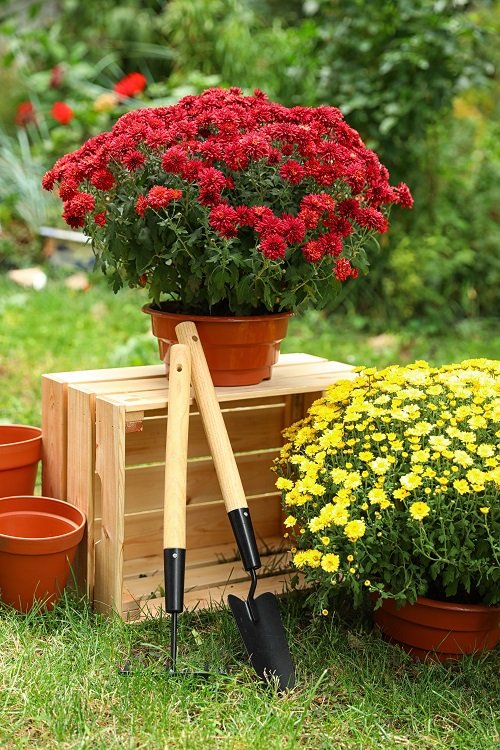Not sure What to do with Potted Mums After Blooming? This guide will help you take the right care of these plants after they have flowered.
What to Do with Potted Mums After Blooming? If you think the end of the blooming season spells the end for your mums, think again! The journey of these hardy plants is far from over, and what comes next might surprise you.
Find What to Do with Tulips After they Bloom here
What to Do with Potted Mums After Blooming

Enjoy the Blooms While They Last
Before we dive into post-blooming care, take some time to enjoy the beautiful flowers on your potted mums. Mums typically bloom from late summer into the fall, adding a burst of color to your outdoor space. You can also cut some blooms to create colorful indoor arrangements to brighten up your home.
Read Chrysanthemum Morifolium Care and Growing Information here
Overwintering Indoors
1. Cut Back the Foliage
Trim back the dead blooms and any wilted leaves, reducing the stems to about 3-4 inches above the soil. After pruning, apply a balanced, slow-release fertilizer to promote new growth.
2. Move Indoors
If your mums are outdoors, bring them inside before the first frost. Place them in a cool, dark area, such as a basement or garage.
Some Important Pointers
- When overwintering chrysanthemums indoors, exposing them to sunlight is usually not necessary. The plants are in a dormant state and don’t require the same level of light as they do during the growing season.
- Place the mums in a cool, dark area like an unheated garage, basement, or even a closet where the temperature stays between 32°F and 50°F. For those using the Celsius scale, this temperature range would be approximately 0°C to 10°C.
- During this dormant period, the plants require very little water. Overwatering can lead to root rot. Keep the soil barely moist but not wet.
- If you notice new growth during the winter, this could be an indication that the plant is not sufficiently dormant, which may mean it’s receiving too much light or warmth.
Check Stunning Types of Chrysanthemum here
Spring Transition
Once the risk of frost has passed in the spring, gradually reintroduce the chrysanthemums to light and warmer temperatures.
Note: If you live in a tropical climate, just keep the plant as it is outdoors – just trim down the spent blooms and yellowing or damaged leaves. Also, trim back the stems to about a third of their length. This will help the plant focus its energy on root development and new foliage.
Transplanting to the Garden
1. Prepare the Garden Bed
Choose a sunny spot with well-drained soil. Add compost or other organic matter to enrich the soil.
2. Transplant
Remove the mum from the pot and place it in a hole that’s as deep as the root ball and twice as wide. Fill the hole with soil and water thoroughly.
3. Cut Back and Mulch
Cut the stems back to 3-4 inches and apply mulch around the plant to protect it from winter frost.
Learn How to Grow Chrysanthemums in Pots here
Adding Mums to the Compost Pile
If you don’t wish to keep your mums, the plant material can be added to a compost pile, contributing valuable organic matter.
Gather the plant material, chop or shred it for faster decomposition, and mix it with brown materials like leaves or straw. Maintain proper moisture levels, turn the pile regularly, and be patient, as composting takes time, typically six months to a year.
Once ready, use the nutrient-rich compost to improve soil quality and promote healthy plant growth in your garden. Composting is an eco-friendly practice that benefits both your garden and the environment.
Check out Chrysanthemum Flower Tattoo Meaning and Significance here
What to Do with Potted Mums After Blooming – FAQs
1. When will my potted mums bloom again after their initial blooming period?
With proper care, potted mums can rebloom in the following season. Regular deadheading, pruning, and providing appropriate growing conditions can help ensure a healthy and vibrant display in the future.
2. Is it necessary to replant potted mums every year after they finish blooming?
Potted mums are perennials, which means they can come back year after year. However, it’s a good practice to repot or divide them every few years to ensure their continued health and vigor.
Check Plants that Bloom Instantly After Planting here
3. How do I prevent diseases and pests in my potted mums after blooming?
Keep an eye out for signs of disease or pests and address them promptly. Good garden hygiene, proper watering, and avoiding over-crowding can help prevent these issues. Additionally, avoid adding diseased plant material to your compost pile.



